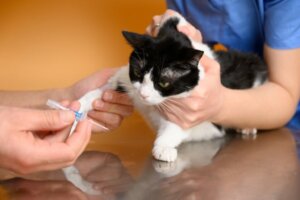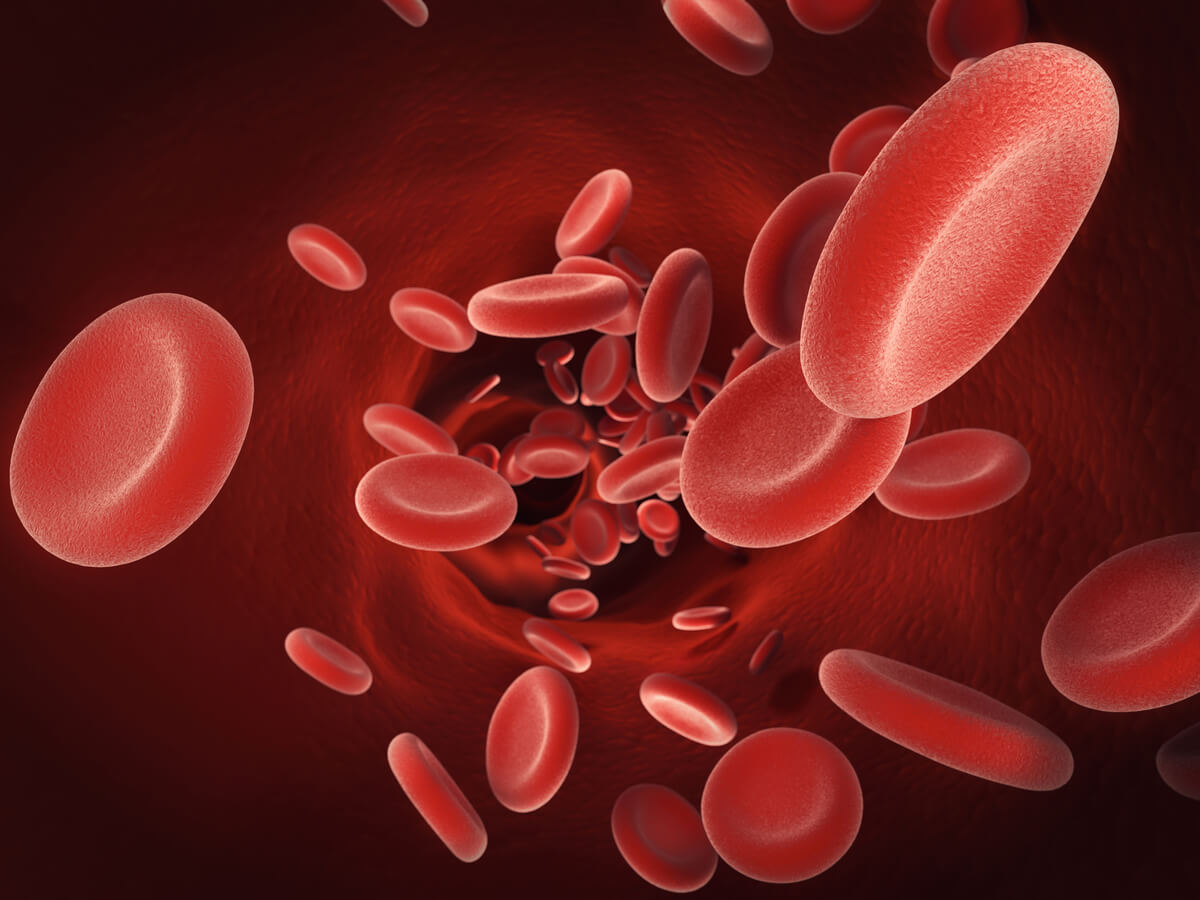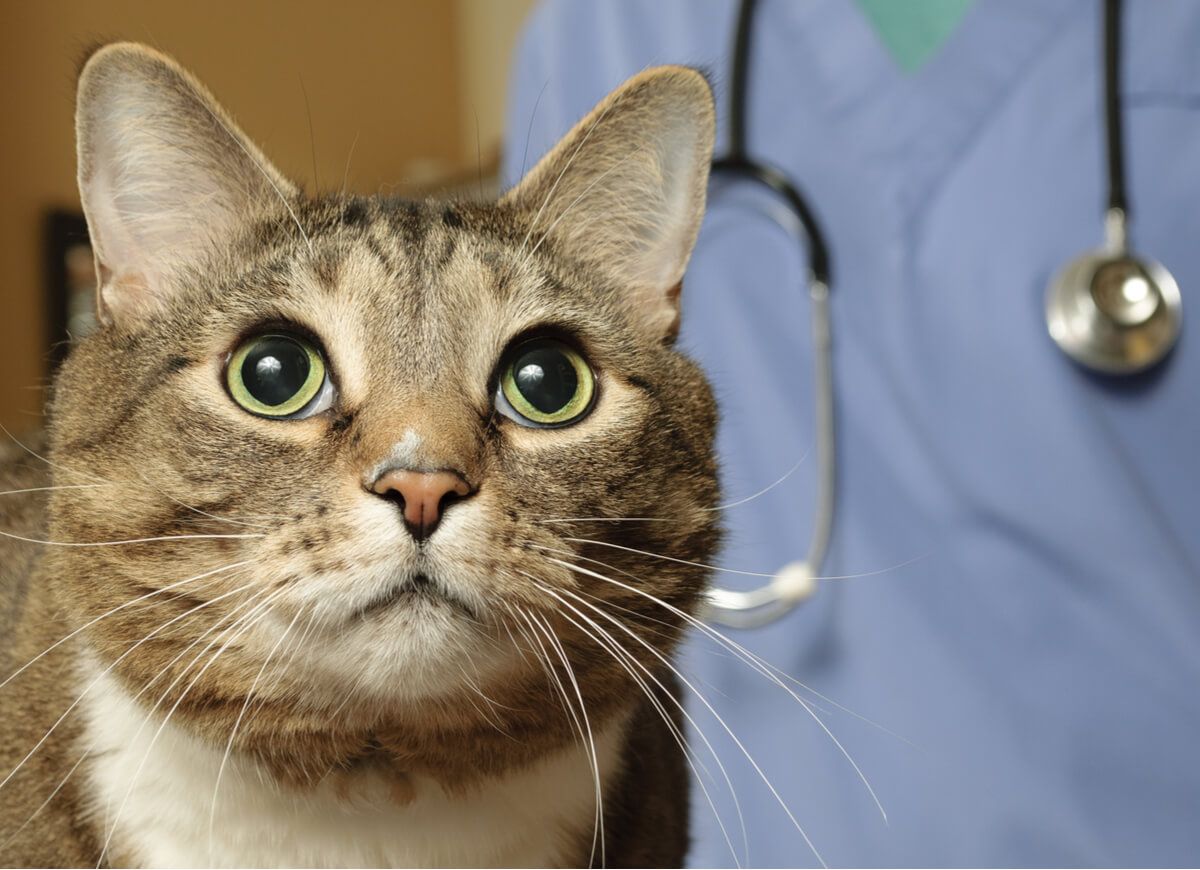Types of Anemia in Cats

A lack of red blood cells affects all animals equally, as these cells are responsible for oxygenating the body’s tissues. In this article, you can learn more about the types of anemia in cats, and how it’s due to the deficit of erythrocytes in blood.
If you think your cat could be suffering from this disease or you’re just curious about the world of veterinary medicine, then this article is for you. However, remember that only a veterinarian is qualified to make a diagnosis when examining the symptoms of your pet.
What’s anemia in cats?
The term anemia refers to the pathological condition consisting of a decrease of erythrocytes (red blood cells) in the blood. These cells contain a pigment called hemoglobin, which is responsible for collecting oxygen and carbon dioxide molecules in the blood. Therefore, when these cells are in short supply, the body’s oxygenation begins to fail.

Symptoms of anemia
Because the body isn’t getting all the oxygen it needs, its basic functions deteriorate. This deficit produces the following visible symptoms:
- Weakness: The cat is listless, doesn’t move, doesn’t want to play, and sleeps more than usual.
- The pallor of the mucous membranes: The peripheral blood supply is diverted when there’s anemia, because the oxygenation of vital organs is prioritized.
- Accelerated breathing: This occurs because the body tries to take more air to capture more oxygen than normal, since there are fewer red blood cells to transport it. If your cat has more than 30 breaths per minute, it’s is a bad sign.
- Lack of appetite: Its weakness will make your cat feel sick, so they won’t want to eat.
- Bad breath: Make sure that halitosis isn’t due to a dental problem.
Causes of anemia in cats
Anemia is often secondary to other pathologies, such as kidney failure, endocrine diseases and even immune system problems. Hemorrhages also eventually lead to anemia due to blood loss, whether external or internal.
Anemia can be due to loss of red blood cells, a lack of red blood cell synthesis, or the pathological destruction of red blood cells.
Types of anemia in cats
Regardless of the origin of anemia, this pathology can occur in two different ways. Below you can read about them in detail, as well as finding out what treatment is used for them.
Regenerative anemia
While any anemia can threaten the life of your cat, regenerative anemia is the one that has the best prognosis. In regenerative anemia, although the loss of red blood cells is pathological, the bone marrow is still able to continue producing blood cells.
An example of regenerative anemia is one caused by an external haemorrhage. It’s enough to simply close the wound and keep the animal stable until the marrow replenishes the erythrocytes that have been lost.
As its name suggests, this anemia can be reversed if the original causes are solved. Treatment is usually directed at these causes while being supplemented with fluid therapy and supplementation of the substances that have been lost with the blood.
Non-regenerative anemia
This is the most severe of the types of anemia in cats. It occurs because the animal is unable to synthesize blood cells normally and the underlying agent is bone marrow involvement. There are several causes capable of impairing the creation of erythrocytes, among which we highlight the following:
- Chronic renal failure: This is caused by a decrease in the concentration of circulating erythropoietin, the hormone that stimulates the production of red blood cells.
- Endocrine diseases, such as hyperadrenocorticism (also known as Cushing’s syndrome).
- Nutritional deficiencies, especially iron deficiency.
- Bone marrow hypoplasia or aplasia.
- Feline leukemia: This disease affects the bone marrow in its most severe variants.
- Feline infectious peritonitis (FIP), a fatal disease caused by a type of coronavirus.
In these cases, the treatment will depend on the state of the bone marrow and the pathology underlying the anemia. It’s usually prolonged in time and is more oriented to give quality of life to the animal and to compensate for the loss of red blood cells as far as possible, but not to provide a definitive solution.
I think my cat has anemia, what should I do?
If you have observed signs of any of the types of anemia in cats that we have explained, don’t hesitate to go to the vet, because it’s a pathology that can compromise the life of your animal. In addition, it’ll also be necessary to detect the cause of anemia as soon as possible.
Conditions such as internal bleeding or accidental poisoning require immediate treatment, especially if they’re already causing anemia.
The first thing they’ll do at the clinic will be to check the total number of red blood cells in the feline’s blood, along with their size and shape. They’ll use a haemogram for this purpose. In addition to this, the relevant tests will also be carried out to find the pathology that’s causing the anemia. Once discovered, you can apply the appropriate treatments to the results obtained.

Finally, remember that regular checkups of your cat’s health are a good way to prevent many serious diseases that can cause anemia. It’s true that cats don’t usually like going to see the vet, but we assure you that the stress involved is much better than not detecting a life-threatening disease in time.
A lack of red blood cells affects all animals equally, as these cells are responsible for oxygenating the body’s tissues. In this article, you can learn more about the types of anemia in cats, and how it’s due to the deficit of erythrocytes in blood.
If you think your cat could be suffering from this disease or you’re just curious about the world of veterinary medicine, then this article is for you. However, remember that only a veterinarian is qualified to make a diagnosis when examining the symptoms of your pet.
What’s anemia in cats?
The term anemia refers to the pathological condition consisting of a decrease of erythrocytes (red blood cells) in the blood. These cells contain a pigment called hemoglobin, which is responsible for collecting oxygen and carbon dioxide molecules in the blood. Therefore, when these cells are in short supply, the body’s oxygenation begins to fail.

Symptoms of anemia
Because the body isn’t getting all the oxygen it needs, its basic functions deteriorate. This deficit produces the following visible symptoms:
- Weakness: The cat is listless, doesn’t move, doesn’t want to play, and sleeps more than usual.
- The pallor of the mucous membranes: The peripheral blood supply is diverted when there’s anemia, because the oxygenation of vital organs is prioritized.
- Accelerated breathing: This occurs because the body tries to take more air to capture more oxygen than normal, since there are fewer red blood cells to transport it. If your cat has more than 30 breaths per minute, it’s is a bad sign.
- Lack of appetite: Its weakness will make your cat feel sick, so they won’t want to eat.
- Bad breath: Make sure that halitosis isn’t due to a dental problem.
Causes of anemia in cats
Anemia is often secondary to other pathologies, such as kidney failure, endocrine diseases and even immune system problems. Hemorrhages also eventually lead to anemia due to blood loss, whether external or internal.
Anemia can be due to loss of red blood cells, a lack of red blood cell synthesis, or the pathological destruction of red blood cells.
Types of anemia in cats
Regardless of the origin of anemia, this pathology can occur in two different ways. Below you can read about them in detail, as well as finding out what treatment is used for them.
Regenerative anemia
While any anemia can threaten the life of your cat, regenerative anemia is the one that has the best prognosis. In regenerative anemia, although the loss of red blood cells is pathological, the bone marrow is still able to continue producing blood cells.
An example of regenerative anemia is one caused by an external haemorrhage. It’s enough to simply close the wound and keep the animal stable until the marrow replenishes the erythrocytes that have been lost.
As its name suggests, this anemia can be reversed if the original causes are solved. Treatment is usually directed at these causes while being supplemented with fluid therapy and supplementation of the substances that have been lost with the blood.
Non-regenerative anemia
This is the most severe of the types of anemia in cats. It occurs because the animal is unable to synthesize blood cells normally and the underlying agent is bone marrow involvement. There are several causes capable of impairing the creation of erythrocytes, among which we highlight the following:
- Chronic renal failure: This is caused by a decrease in the concentration of circulating erythropoietin, the hormone that stimulates the production of red blood cells.
- Endocrine diseases, such as hyperadrenocorticism (also known as Cushing’s syndrome).
- Nutritional deficiencies, especially iron deficiency.
- Bone marrow hypoplasia or aplasia.
- Feline leukemia: This disease affects the bone marrow in its most severe variants.
- Feline infectious peritonitis (FIP), a fatal disease caused by a type of coronavirus.
In these cases, the treatment will depend on the state of the bone marrow and the pathology underlying the anemia. It’s usually prolonged in time and is more oriented to give quality of life to the animal and to compensate for the loss of red blood cells as far as possible, but not to provide a definitive solution.
I think my cat has anemia, what should I do?
If you have observed signs of any of the types of anemia in cats that we have explained, don’t hesitate to go to the vet, because it’s a pathology that can compromise the life of your animal. In addition, it’ll also be necessary to detect the cause of anemia as soon as possible.
Conditions such as internal bleeding or accidental poisoning require immediate treatment, especially if they’re already causing anemia.
The first thing they’ll do at the clinic will be to check the total number of red blood cells in the feline’s blood, along with their size and shape. They’ll use a haemogram for this purpose. In addition to this, the relevant tests will also be carried out to find the pathology that’s causing the anemia. Once discovered, you can apply the appropriate treatments to the results obtained.

Finally, remember that regular checkups of your cat’s health are a good way to prevent many serious diseases that can cause anemia. It’s true that cats don’t usually like going to see the vet, but we assure you that the stress involved is much better than not detecting a life-threatening disease in time.
All cited sources were thoroughly reviewed by our team to ensure their quality, reliability, currency, and validity. The bibliography of this article was considered reliable and of academic or scientific accuracy.
- GEMFE : Peritonitis infecciosa felina (PIF). (s. f.). AVEPA. Recuperado 26 de noviembre de 2021, de https://www.avepa.org/articulos/Peritonitis%20infecciosa%20felina%20(PIF).html
- Ravicini, S., & Milán, J. P. (2010). Diagnóstico de anemia en gatos. Canis et felis, (107), 30-38.
- Scodellaro, C. F., Pintos, M. E., Stornelli, M. C., & Arauz, M. S. (2006). Anemias regenerativas en caninos y felinos: Revisión bibliográfica I parte. Veterinaria Cuyana, 1.
- Ortiz, J. F. (2011). Leucemia viral felina simultánea con otras patologías en tres casos clínicos diferentes. Revista Colombiana de Ciencias Pecuarias, 24(1), 55-62.
This text is provided for informational purposes only and does not replace consultation with a professional. If in doubt, consult your specialist.








